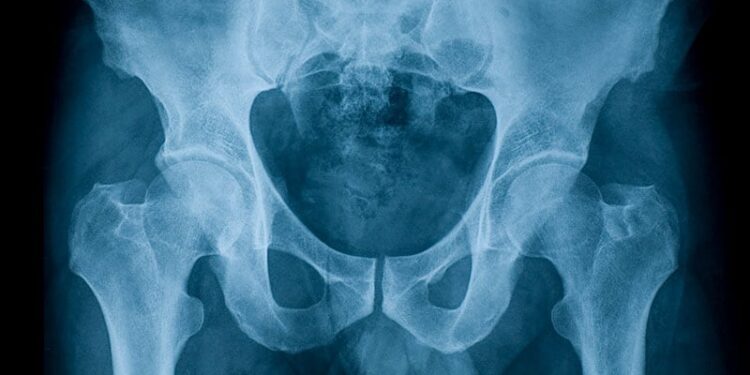BARCELONA, Spain — Data from a prospective imaging study question the use of x-ray radiography first in the diagnostic workup of patients with suspected axial spondyloarthritis (axSpA), a practice that is currently a part of recommendations by the European Alliance of Associations for Rheumatology (EULAR).
The study, which evaluated three different imaging pathways based on whether x-ray radiography, MRI, or CT of the sacroiliac joint (SIJ) was used first, found that the two latter approaches yielded a higher diagnostic efficacy than the radiograph-first approach.
While just 13% of 30 people who were in the radiograph-first arm of the study were confirmed as having axSpA after the initial scan, 22% of 91 patients in the MRI-first and 30% of 84 people in the CT-first arms were given an axSpA diagnosis.
X-ray, MRI, or CT first?

“To x-ray or not to x-ray? What may sound somewhat philosophical, is a relevant question,” said study investigator Dominik Deppe, MD, who presented the findings at European Alliance of Associations for Rheumatology (EULAR) 2025 Annual Meeting.
Deppe, a doctoral student in the Department of Radiology at Charité – Universitätsmedizin Berlin, Berlin, Germany, explained that although radiographs could show certain structural lesions, such as erosions, sclerosis, or ankylosis, and used relatively low levels of radiation, interpretation could be problematic.
“Even among experts, inter-reader reliability remains low,” Deppe said. MRIs are often performed if the results on radiography are negative or inconclusive. Such scans provide additional insights, he added, and can show both structural and inflammatory lesions, such as bone marrow edema. However, the high cost and low availability of MRI relative to radiography, however, were issues, he acknowledged.
This is where CT could perhaps prove most useful. Although it’s not part of the standard imaging pathway as yet, it is “a gold standard for structural lesions,” Deppe said.
He added: “Historically, CT is considered to have high radiation exposure, but nowadays, we can perform CT with ultra-low dose techniques that allow us to reduce radiation exposure to a level that is comparable, or even less, compared to conventional x-rays.”
Strategies Compared and Results
The study included 205 people with suspected axSpA, who were randomly allocated into one of three arms: 30 to a radiograph-first or “standard” arm, 91 to an MRI-first arm, and 84 to a CT-first arm.
Scans were designated positive or negative by the consensus of two specialized musculoskeletal radiologists who were blinded to the clinical data. A positive result was defined as clear signs of structural or inflammation suggestive of axSpA and no further imaging was done. Those with negative scans underwent a subsequent scan with another method; those in the radiograph-first arm had an MRI scan and then a CT scan, those in the MRI-first arm had a CT scan, and those in the CT-first arm had an MRI scan.
The results are preliminary because the study is ongoing and results from the final diagnosis by a rheumatologist are not yet available, Deppe said. He reported that in the radiograph-first arm, 26 (87%) people had a negative scan and then had an MRI scan. This was positive in three (11%) and negative in 23 (88%) of people. None of the people with a negative MRI scan had a positive CT scan.
In the MRI-first arm, scans were positive in 20 (22%) and negative in 71 (78%) of people. Again, CT added no further cases among the people who were also MRI-negative.
Finally, in the CT-first arm, there were 25 (30%) positive and 59 (70%) negative scans. MRI performed in the CT-negative patients detected two (3%) additional cases of confirmed axSpA.
Deppe said: “Our standard approach, [which] we’re using right now, has the lowest diagnostic efficacy, compared to the MRI-first and CT-first approach.”
Patient Characteristics
Information about patient demographics were not presented, however, which prompted Uta Kiltz, MD, a senior rheumatologist at Rheumazentrum Ruhrgebiet, Herne, Germany, to ask for clarification and about the study design.
“Can you give some information about the population you included in the study?” she asked. “I think we need to have some more context about the decision-making process to really understand the results.”
Deppe responded that the patients had been referred with the suspicion and not confirmed diagnosis of axSpA and had been randomized through a third party into the three different imaging arms.
Topline patient demographics had been given in the abstract, which stated that the mean age of the population studied was 38 years (SD, 10.58 years) and just over half (58%) were women.
Around half (53%) of the study population was HLA-B27 positive. The mean C-reactive protein level was 3.66 mg/L, and the mean BMI was 25.57.
The mean duration of back pain was around 8 years, and 70.6% of people had signs of inflammatory back pain.
Questions Raised
Several discussants raised concerns about the study design and the interpretation of these early findings.
Eric Ruderman, MD, of Northwestern University Feinberg School of Medicine, Chicago, questioned why all patients did not receive all three imaging modalities: “Ultimately, you don’t know the diagnostic specificity of the [ultra] low-dose CT. Why didn’t you do all three images in each patient, so that you can actually make a comparison once you have the confirmed diagnosis?”
Deppe replied that the team wanted to be pragmatic: “We wanted to evaluate the clinical settings where the patient does not undergo every imaging, but if we found positive results, as in the clinical practice, we don’t need further imaging, and this is something we want to demonstrate in the study.”
Xenofon Baraliakos, MD, head of rheumatology at the Rheumazentrum Ruhrgebiet, and the new president of EULAR, raised concerns about potential false positives: “What happens if the x-ray is positive…but it was falsely positive? Have you been able to check for that?”
Deppe acknowledged the limitation: “I think this is something we have to do when we have the final diagnosis by the rheumatologist, to see whether we missed or misinterpreted some of the images.”
This study was independently supported. Deppe had no conflicts of interest. The commentators were not involved in the study.
Sara Freeman, MSc, is a freelance medical journalist based in London, England. She has been reporting for specialist healthcare news organizations for more than 20 years.
Source link : https://www.medscape.com/viewarticle/first-scan-suspected-axial-spondyloarthritis-x-rays-mri-or-2025a1000gh2?src=rss
Author :
Publish date : 2025-06-20 09:55:00
Copyright for syndicated content belongs to the linked Source.


